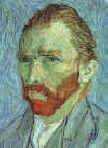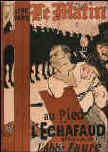|



From the first time humans scratched images onto the walls of caves, until the middle
of the 19th century, artists held a special place in society. They possessed a unique
skill developed from talent and training over many years. They could create images that
represented objects or ideas from the "real" world. Sometimes these images were
stylized, idealized, or expressively distorted, but they were always representational.
When a culture expressed itself visually, it needed artists to do the work!
By the middle of the 19th century, all this had changed. The invention of photography
radically changed the world in which artists lived and worked. A traditional painter would
need years of academic
training or apprenticeship
for his work to be accepted. A photographer might need only a few hours of training and a
minimal amount of equipment in order to produce images that were in many ways more
"real" than those created by traditional painters.
Painters met this challenge in a variety of ways:
-
Since early photography was exclusively black and white, painters began to investigate
and exploit color.
-
Photographs were flat so artists like
Vincent
Van Gogh
began to use thick textured
paint, sometimes squeezed directly from the tube onto the canvas.
-
Initially, photographs were limited to what was actually "in front of the
lens", but painters could expand, distort or invent images.
-
With the development of better lenses and projecting equipment, artists began to use
photographs to facilitate drawing.
As a result, Impressionism developed during the last half of the 19th
century. It was a style created by anti-establishment artists that revolutionized the way
the world looked at art and artists. Impressionist artists claimed to be attempting to
capture the "transitory"
effects of light and color... a far cry from classical ideal form.
These artists were no
longer entirely dependent on the whim of wealthy patrons who had controlled and influenced
artistic output for centuries. Vincent
Van Gogh was supported financially and emotionally by his brother, Theo. Some, like
Henri de Toulouse-Lautrec
,
were from wealthy families or drew income from commercial work, as did Toulouse-Lautrec
with his posters.
Of the artists who participated in the first impressionist exhibition,
only Claude Monet
remained true throughout his career to the principals of Impressionism. Paul C�zanne,
Georges Seurat
,
Vincent Van Gogh,
Paul
Gauguin
,
Pierrre
Auguste Renoir
,
Edouard
Manet
,
Edgar
Degas
and others sought more solid form and more individual expression. These
artists became know as Post-impressionists. It was from these artists
that many in the movements we have come to know as "Modern Art" drew their
inspiration.
|

Vincent Van Gogh
"Self Portrait"

Henri Toulouse-Lautrec
"Au Pied de l'Echafaud"
(At the Foot of the Gallows)

Claude Monet
"Impression: Sunrise"
|

Additional Resources

[ Impressionism Things to Know ] [ Impressionism Questions ] [ Impressionism Critical Thinking ]

|
![]()